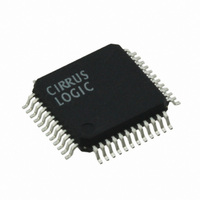CS4954-CQZ Cirrus Logic Inc, CS4954-CQZ Datasheet - Page 25

CS4954-CQZ
Manufacturer Part Number
CS4954-CQZ
Description
IC VIDEO ENCODER NTSC/PAL 48TQFP
Manufacturer
Cirrus Logic Inc
Type
Video Encoderr
Datasheet
1.CS4954-CQZ.pdf
(60 pages)
Specifications of CS4954-CQZ
Package / Case
48-TQFP, 48-VQFP
Voltage - Supply, Analog
3.15 V ~ 5.25 V
Voltage - Supply, Digital
3.15 V ~ 5.25 V
Mounting Type
Surface Mount
Operating Supply Voltage
3.3 V / 5 V
Supply Current
70 mA
Maximum Operating Temperature
+ 85 C
Minimum Operating Temperature
- 40 C
Mounting Style
SMD/SMT
Number Of Channels
2
Resolution
10 bit
Snr
70 dB
Input Format
Digital
Output Format
Analog
Supply Voltage Range
3.15V To 3.45V
Operating Temperature Range
-40°C To +85°C
Tv / Video Case Style
TQFP
No. Of Pins
48
Tv / Video Type
Encoder
Rohs Compliant
Yes
Filter Terminals
SMD
Lead Free Status / RoHS Status
Lead free / RoHS Compliant
For Use With
CDB4955A - EVALUATION BOARD FOR CS4955A
Applications
-
Lead Free Status / Rohs Status
Lead free / RoHS Compliant
Other names
598-1682
Available stocks
Company
Part Number
Manufacturer
Quantity
Price
Part Number:
CS4954-CQZ
Manufacturer:
CIRRUS
Quantity:
20 000
Company:
Part Number:
CS4954-CQZR
Manufacturer:
NXP
Quantity:
11 000
Company:
Part Number:
CS4954-CQZR
Manufacturer:
Cirrus Logic Inc
Quantity:
10 000
Part Number:
CS4954-CQZR
Manufacturer:
CIRRUS
Quantity:
20 000
TTXRQ provides a fully programmable request
signal to the teletext source, indicating the insertion
period of the bitstream at independently selectable
lines for both TV fields. The internal insertion win-
dow for text is set to either 360, 296 or 288 teletext
bits, depending on the selected teletext standard.
The clock run-in is included in this window.
Teletext in enabled by setting the TTX_EN bit to
“1”. The TTX_WST bit in conjunction with the
TV_FORMAT register selects one of the 4 teletext
encoding possibilities.
The teletext timing is shown in the Figure 12.
TTXHS and TTXHD are user programmable and
therefore allow the user to have full control over
when teletext data is sent to this device.
The time t
text input data and insert it into the CVBS and Y
output signals, such that it appears between
t
edge of the horizontal synchronization pulse. t
changes with the TV standard and the selected
teletext standard. Please refer to ITU-R BT.653-2
for more detailed information.
The time t
by the source that is gated by TTXRQ in order to
deliver teletext data. This delay is programmable
through the register TTXHD. For every active
HIGH transition at output pin TTXRQ, a new tele-
text bit must be provided by the source. The time
between the beginning of the first TTXRQ pulse
DS278F6
TTX
TTXDAT
CVBS/Y
TTXRQ
= 9.8 μs and t
Figure 12. Teletext Timing (Pulsation Mode)
FD
PD
is the time needed to interpolate tele-
is the pipeline delay time introduced
t
TTX
TTX
textbit #: 1
t
PD
= 12 μs after the leading
t
FD
2
3
4
t
TTXWin
5
FD
TTXDAT
CVBS/Y
TTXRQ
and the leading edge of H-sync is programmable
through the TTXHS register.
Since the beginning of the pulses representing the
TTXRQ signal and the delay between the rising
edge of TTXRQ and valid teletext input data are
fully programmable, the TTXDAT data is always
inserted at the correct position after the leading
edge of the outgoing horizontal synchronization
pulse.
The time t
window for TTX data; it has a constant length
depending on the selected teletext standard which
allows insertion of 360 TTX bits (6.9375
Mbit/sec) (European teletext) or 296 TTX bits
(5.6427875 Mbit/sec) (WST PAL) or 288 TTX bits
(5.727272 Mbit/sec) (NABTS) or 296 TTX bits
(5.727272 Mbit/sec) (WST NTSC) respectively.
Using the appropriate programming, all suitable
lines of the odd field (TTXOVS through TTX-
OVE) plus all suitable lines of the even field
(TTXEVS through TTXEVE) can be used for tele-
text insertion. In addition it is possible to selec-
tively disable the teletext insertion on single lines.
This can be programmed by setting the
TTX_LINE_DIS1,
TTX_LINE_DIS3 registers appropriately.
Note that the TTXDAT signal must be synchro-
nized with the 27 MHz clock. The pulse width of
the TTXRQ signal varies between three and four
27 MHz clock cycles. The variation is necessary in
Figure 13. Teletext Timing (Window Mode)
TTXWin
t
TTX
textbit #: 1
t
is the internally used insertion
PD
TTX_LINE_DIS2
t
CS4954 CS4955
FD
2
3
4
t
TTXWin
5
and
25
















